Dreaming of fresh homegrown vegetables but short on space? Container gardening might be your perfect solution! Whether you’ve got a tiny balcony, small patio, or just want to maximize your existing garden, growing vegetables in containers offers endless creative possibilities while bringing beauty and abundance to any space.
You don’t need a sprawling backyard to enjoy the satisfaction of harvesting your own produce. From hanging baskets filled with strawberries to repurposed buckets bursting with lettuce, container vegetable gardens can thrive in surprising places. Even traditionally ground-loving plants like cabbage and spinach can flourish in the right container setup, while herbs and compact vegetables like radishes and green onions are particularly well-suited for small-space gardening.
Benefits of Growing Vegetables in Containers
Container gardening offers many advantages that make it an ideal choice for both novice and experienced gardeners. Here’s why growing vegetables in containers might be the perfect solution for your gardening needs.
Maximizing Limited Space
Container gardening transforms even the smallest areas into productive growing spaces. You can place containers on balconies, patios, driveways, windowsills, or tiny yards to grow fresh produce without requiring a traditional garden plot. Vertical container gardens allow you to stack plants upward rather than outward, multiplying your growing area in limited spaces. Even apartment dwellers can grow a surprising amount of food using strategic container placement to take advantage of available sunlight throughout the day.
Controlling Soil Quality and Conditions
With containers, you have complete control over your growing medium. This advantage lets you bypass poor native soil conditions like heavy clay, rocky terrain, or contaminated urban soils. You can customize your potting mix for exact plants, adjusting pH levels and nutrient content to create ideal growing conditions for each vegetable variety. Container soil also warms faster in spring, allowing for earlier planting and extending your growing season by several weeks compared to in-ground gardens.
Reducing Pest and Disease Problems
Container gardening significantly decreases your battle against common garden challenges. Elevated containers reduce access for ground-dwelling pests like slugs, snails, and some insects. Soilborne diseases that might plague in-ground gardens are minimized when using fresh potting mix in containers. The ability to closely monitor your plants makes early detection of problems easier, allowing you to address pest issues before they become infestations. Container gardens also typically experience fewer weed problems, reducing competition for nutrients and water.
Accessibility for All Gardeners
Container gardening makes growing vegetables possible for people with physical limitations or mobility challenges. Raised containers eliminate the need for kneeling or excessive bending, making gardening activities more comfortable. You can position containers at various heights to accommodate different needs, from tabletop planters to elevated garden beds. The reduced maintenance requirements of container gardens—less weeding, thinning, and pest management—also make vegetable growing more manageable for busy gardeners or those with limited physical capabilities.
Choosing the Perfect Containers for Your Vegetable Garden
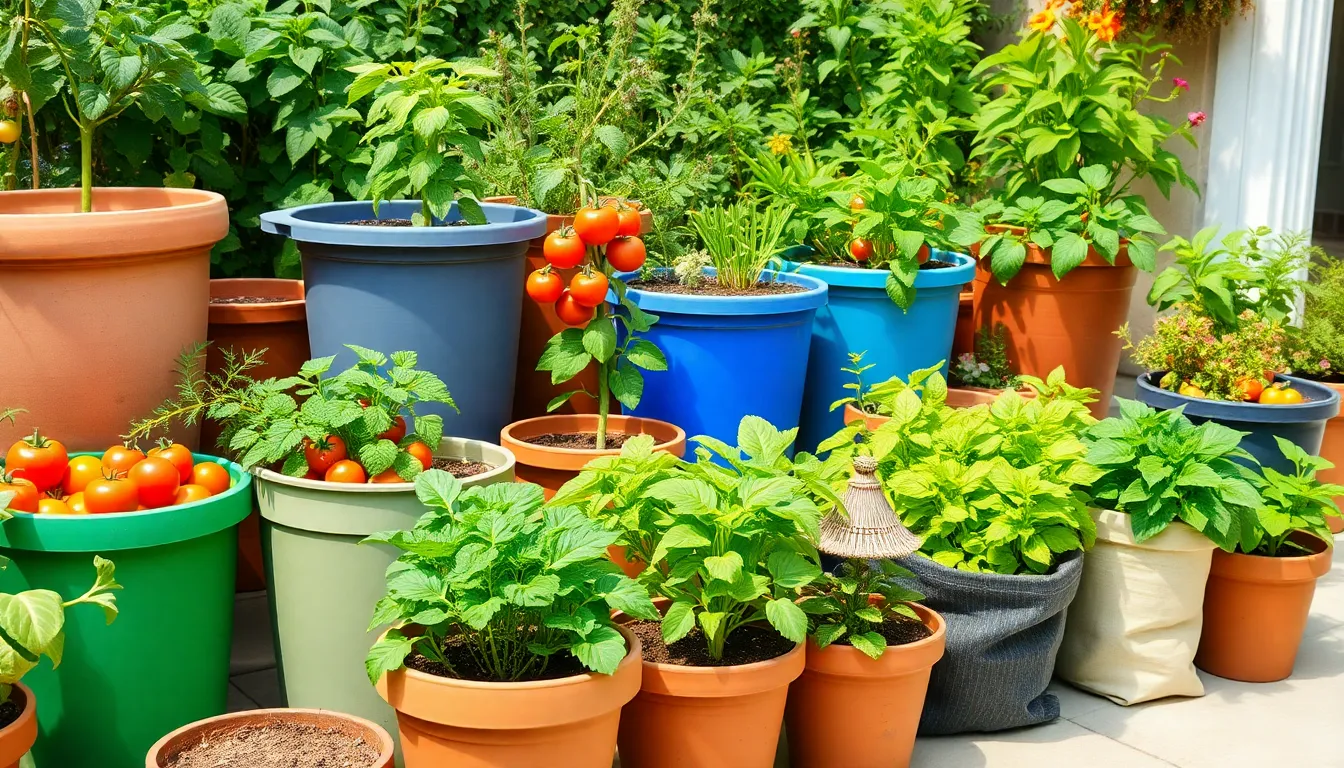
Container Size Requirements for Different Vegetables
Container size directly impacts how well your vegetables grow. Large containers (5-gallon or larger) work best for deep-rooted plants like tomatoes, peppers, and eggplants, providing 18-24 inches of depth for proper root development. Medium-sized containers (2-3 gallons) accommodate bush varieties like cucumbers, beans, and compact vegetables including lettuce, spinach, beets, and cabbage. Small containers work for herbs and shallow-rooted vegetables like radishes and green onions.
| Vegetable | Recommended Container Size | Number of Plants | Container Depth |
|---|---|---|---|
| Tomatoes | 5-gallon pot (12″ diameter) | 1 plant | 18-24 inches |
| Radishes | 2-gallon pot (8-9″ diameter) | 5-6 plants | 6-8 inches |
| Peppers | 3-5 gallon pot | 1-2 plants | 12-18 inches |
| Lettuce | 2-gallon pot | 4-6 plants | 6-8 inches |
| Carrots | 2-3 gallon pot | 10-12 plants | 12-14 inches |
To maximize your harvest, try companion planting by combining tall climbers with low-growing plants in the same container. The climbers will grow up trellises while smaller plants spread around the base, creating a space-efficient garden that leaves little room for weeds.
Material Options: Pros and Cons
Your container material choice affects plant health, durability, and aesthetics. Each option has distinct advantages and disadvantages to consider:
- Plastic Containers: Affordable, lightweight, and retain moisture well. Available in many colors and sizes, they’re easy to clean and reuse for multiple seasons. Choose food-grade plastic for edibles to prevent chemical leaching. The downside? They can deteriorate in strong sunlight over time.
- Ceramic/Terracotta: These attractive containers come in glazed or unglazed options. Unglazed terracotta breathes well but dries out quickly, requiring more frequent watering. They’re heavier than plastic, especially when filled with soil, and can crack in freezing temperatures.
- Fabric Grow Bags: These breathable containers promote healthy root systems through air pruning. They’re lightweight, foldable for storage, and affordable. The drawback is they dry out faster than solid containers and may degrade after several seasons.
- Metal Containers: Galvanized tubs and stock tanks offer durability and a trendy aesthetic. Avoid using dark metal containers that heat up quickly and can damage roots. Ensure proper drainage holes to prevent water buildup.
- Wooden Planters: These offer natural insulation for roots and blend beautifully with outdoor spaces. Use untreated wood for edibles to avoid chemical exposure. Wood will eventually rot, giving these containers a shorter lifespan.
Remember, regardless of material, all containers need drainage holes to prevent waterlogged soil and root rot.
Self-Watering Container Answers
Self-watering containers solve one of container gardening’s biggest challenges: consistent moisture. These systems include a water reservoir beneath the soil that plants can access as needed, reducing watering frequency from daily to weekly in many cases.
These containers work through capillary action, with the plant roots growing down to tap the reservoir. While not truly “self-watering” (you’ll still need to fill the reservoir), they provide several advantages:
- Prevent drought stress by maintaining consistent moisture levels
- Reduce watering frequency, perfect for busy gardeners
- Minimize water waste through evaporation
- Create ideal growing conditions for thirsty vegetables like tomatoes and cucumbers
You can purchase commercial self-watering containers or easily DIY them using plastic storage bins or buckets. Simply create a water chamber at the bottom, add a wicking mechanism to draw moisture upward, and include an overflow hole to prevent waterlogging.
For vegetables that prefer drier conditions, like herbs and root crops, traditional containers might be a better choice as they provide better drainage and soil aeration.
Upcycled and Creative Container Ideas
Transform everyday items into unique planters while reducing waste and saving money. These creative container garden ideas add personality to your space:
- 5-Gallon Buckets: These inexpensive workhorses are perfect for growing tomatoes, peppers, and other large vegetables. Paint them in bright colors for added visual appeal.
- Wooden Crates and Wine Boxes: These rustic containers work beautifully for shallow-rooted crops like lettuce, radishes, and herbs. Line with industry fabric to retain soil while allowing drainage.
- Reused Shopping Bags: Strong reusable shopping bags can be transformed into instant grow bags for potatoes, carrots, and other root vegetables.
- Gutters and Pipes: Mount rain gutters on a fence or wall for a space-saving lettuce and herb garden. Ensure proper drainage by slightly angling the gutter.
- Old Boots and Shoes: These whimsical planters work great for small herbs and make charming garden accents.
- Recycled Plastic Bottles: Cut and arrange bottles horizontally or vertically to create unique hanging or wall gardens for small herbs and greens.
- Wheelbarrows and Wagons: Repurpose old wheelbarrows or children’s wagons into mobile garden beds that can be moved to optimize sunlight exposure.
When upcycling containers, ensure they’re made from food-safe materials, add drainage holes, and consider how the material might affect soil temperature and moisture. The most successful container gardens often combine practical growing considerations with creative expression.
Top 15 Vegetables That Thrive in Containers
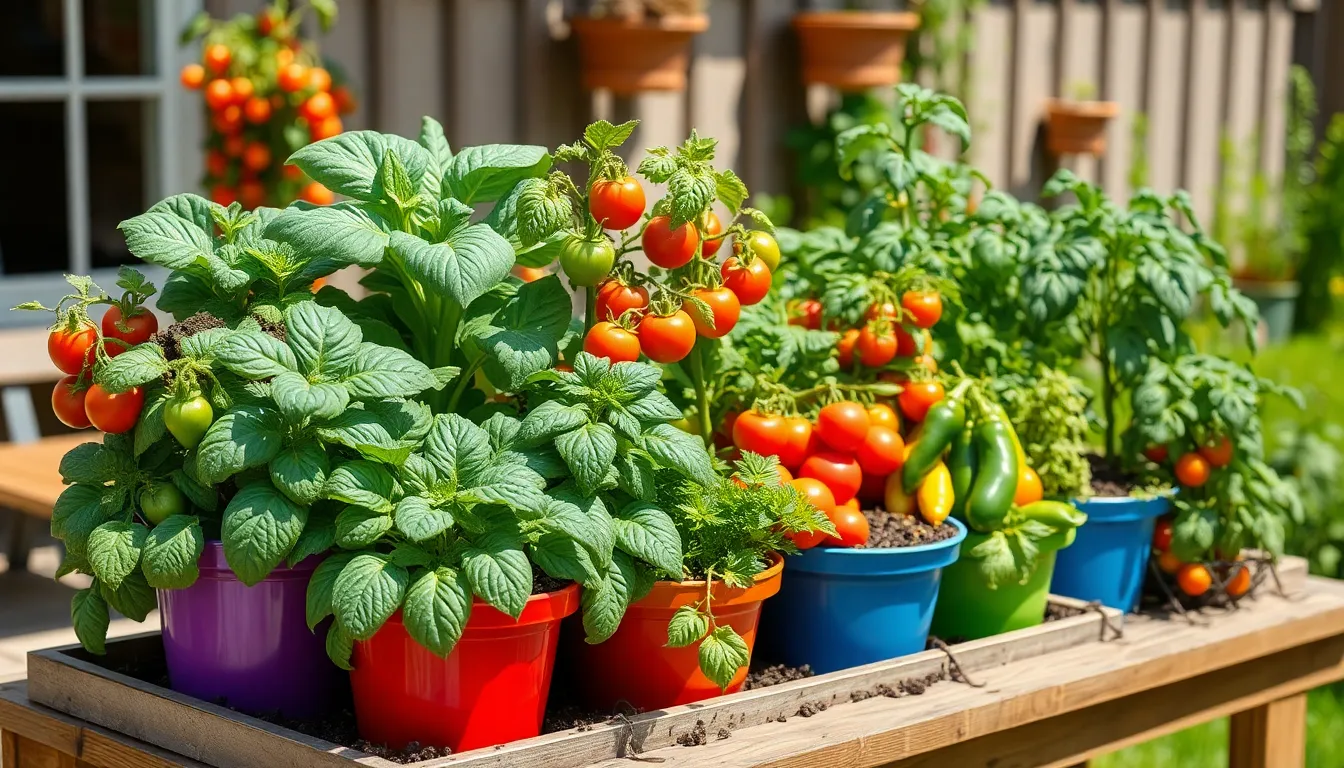
Now that you’ve selected the perfect containers, let’s explore which vegetables will flourish in your container garden. These varieties have been chosen for their adaptability to confined spaces while still producing bountiful harvests.
Leafy Greens: Lettuce, Spinach, and Kale
Leafy greens are perfect container candidates due to their shallow root systems and quick growth. Lettuce thrives in containers as small as 6-8 inches deep and can be harvested multiple times when you pick outer leaves while letting the center continue growing. Try varieties like ‘Buttercrunch’ or ‘Red Sails’ for container cultivation.
Spinach grows beautifully in containers and provides nutrient-dense leaves for salads and cooking. Plant spinach in early spring or fall since it prefers cooler temperatures. A 10-inch pot can accommodate 4-5 spinach plants, giving you weeks of fresh harvests.
Kale is incredibly container-friendly and cold-tolerant, extending your growing season into cooler months. Dwarf varieties like ‘Dwarf Blue Curled’ are ideal for containers, requiring only 12 inches of soil depth. With regular harvesting of outer leaves, a single kale plant can produce for months.
Root Vegetables: Carrots, Radishes, and Beets
Root vegetables need appropriate depth but grow surprisingly well in containers. Carrots require containers at least 12 inches deep for most varieties, though short varieties like ‘Paris Market’ or ‘Thumbelina’ need just 8 inches. Choose a pot with smooth sides to prevent misshapen roots.
Radishes are among the fastest-growing vegetables, ready to harvest in just 3-4 weeks. They need only 6 inches of soil depth, making them perfect for shallow containers or even window boxes. Varieties like ‘Cherry Belle’ and ‘Icicle’ perform exceptionally well in containers.
Beets offer double value with edible roots and nutritious greens. Plant beets in containers at least 10 inches deep, spacing seeds about 3 inches apart. The ‘Bull’s Blood’ variety features striking red foliage that adds visual appeal to your container garden while providing colorful greens for salads.
Nightshades: Tomatoes, Peppers, and Eggplants
Tomatoes are container gardening superstars when you choose the right varieties. Determinate or bush types like ‘Patio’, ‘Tiny Tim’, and ‘Early Girl’ are bred specifically for containers. Use a 5-gallon pot (at least 12 inches in diameter) for a single tomato plant and provide support with stakes or cages.
Peppers, both sweet and hot varieties, flourish in containers. They require less space than tomatoes – a 2-3 gallon pot can support one pepper plant. Compact varieties like ‘Hungarian Wax’ peppers produce abundant fruits and add visual interest with their colorful pods.
Eggplants grow beautifully in containers when provided with warm conditions and consistent moisture. Choose compact varieties like ‘Fairy Tale’ or ‘Hansel’ that stay under 2 feet tall. A 5-gallon container is ideal for a single eggplant, which will reward you with glossy, tender fruits throughout the summer.
Legumes: Beans and Peas
Beans come in bush and pole varieties, both suitable for container growing. Bush beans are self-supporting and perfect for medium-sized containers (at least 8 inches deep). Pole beans need trellising but use vertical space efficiently – plant them along the back of a large container where they can climb up support structures.
Peas are cool-season crops that thrive in spring and fall container gardens. Like beans, they come in bush and climbing varieties. Climbing peas need support but produce more in the same footprint. Plant peas 1-2 inches apart in containers at least 8 inches deep, and harvest regularly to encourage continued production.
Other Container-Friendly Vegetables
Cucumbers, particularly bush or compact varieties like ‘Spacemaster’ or ‘Patio Snacker’, grow well in 5-gallon containers with trellising. Their vining habit makes efficient use of vertical space while keeping fruits clean and easy to harvest.
Zucchini and summer squash can thrive in containers when you select compact bush varieties like ‘Eight Ball’ or ‘Patio Star’. These prolific producers need large containers (at least 5 gallons) and regular harvesting to keep producing.
Green onions (scallions) are perfect for small containers, needing just 6 inches of soil depth. They can be harvested continually by cutting the green tops while leaving the roots to regrow, providing months of fresh flavor from a single planting.
Potatoes grow surprisingly well in containers, with specialized “potato pots” or even large fabric grow bags being ideal. As the plants grow, you add more soil to cover the stems, resulting in more potatoes forming along the buried portions.
Herbs like basil, parsley, cilantro, and thyme make excellent companion plants in vegetable containers. They’re not only space-efficient but also help repel pests and enhance the flavors of neighboring vegetables. A mixed herb container placed near your cooking area provides fresh flavors all season long.
Creating the Ideal Growing Environment

Creating the perfect environment for your container vegetable garden is essential for healthy, productive plants. With the right conditions, even the smallest containers can yield impressive harvests.
Selecting the Right Potting Mix
The foundation of a successful container garden starts with high-quality potting mix. Garden soil is too dense for containers and can harbor diseases and pests. Instead, use a soilless potting mix that provides:
- Proper drainage to prevent waterlogged roots
- Lightweight texture for better aeration
- Disease and pest-free growing medium
Commercial potting mixes typically contain a blend of peat moss or coconut coir, perlite, vermiculite, and sometimes composted bark. For vegetable containers, choose mixes labeled for vegetables or make your own with:
- 1/3 cup blood meal (for nitrogen)
- 1/3 cup colloidal phosphate (for phosphorus)
- 1/3 cup greensand (for potassium and trace elements)
Fill containers to about 1-2 inches below the rim to allow space for watering and to account for soil settling throughout the growing season.
Proper Watering Techniques for Containers
Container plants dry out faster than in-ground gardens and require more attentive watering. Follow these watering best practices:
- Water in the morning to reduce evaporation and fungal issues
- Check moisture levels daily by inserting your finger about an inch into the soil
- Water deeply until moisture drips from drainage holes
- Group plants with similar water needs together
- Use saucers under pots to catch excess water, but empty them after 30 minutes
- Consider self-watering containers or ollas (porous clay pots) for consistent moisture
During hot summer days, container vegetables may need watering twice daily. Add a thin layer of mulch on top of the soil to help retain moisture and reduce watering frequency.
Fertilizing Container Vegetables
Nutrients leach quickly from containers due to frequent watering, making regular fertilization essential. Most vegetables are heavy feeders that require:
- Initial feeding with slow-release organic fertilizer mixed into the potting soil
- Supplemental feeding with liquid fertilizer every 2-4 weeks
- Fish emulsion, seaweed extract, or compost tea applications for micronutrients
Signs your container plants need fertilizer include yellowing leaves, stunted growth, and poor fruit production. Always follow package instructions, as over-fertilizing can damage plants and reduce yields.
Positioning for Optimal Sunlight
Most vegetables require 6-8 hours of direct sunlight daily to produce well. When positioning your containers:
- Place sun-loving plants like tomatoes, peppers, and squash in your sunniest spots
- Group plants with similar light requirements together
- Use south or west-facing locations for maximum sun exposure
- Consider east-facing spots for greens that benefit from morning sun and afternoon shade
- Rotate containers periodically to ensure even growth if plants are leaning toward light
- Use reflective surfaces like white walls or aluminum foil to increase light in shadier areas
Remember that dark-colored containers absorb more heat, which can stress plant roots during summer. Consider using light-colored containers or “double potting” by placing your plant container inside a slightly larger one with insulating material between them.
Space-Saving Container Garden Designs
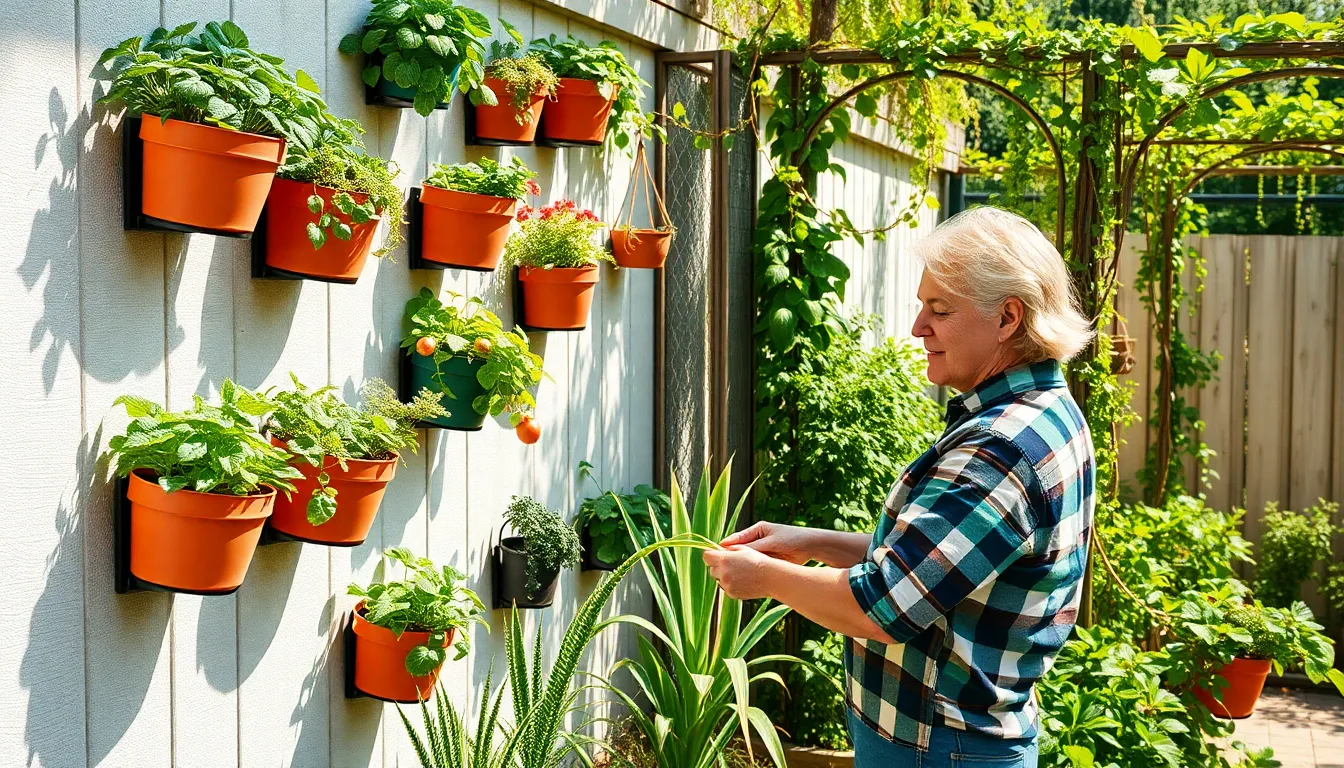
Vertical Growing Systems
Vertical growing systems transform limited horizontal space into productive gardening areas by utilizing walls, fences, and upward structures. These systems improve air circulation around plants, reducing disease risk while making pest management easier. Try these vertical options:
- Wall-mounted planters optimize sunlight exposure for each plant and can turn bare walls into vibrant green spaces
- Trellises and supports for climbing vegetables like cucumbers, beans, and peas save important ground space
- Pocket planters made from canvas or recycled materials can hold multiple plants in a compact footprint
- Pallet gardens repurpose wooden shipping pallets into multi-tiered growing spaces for small vegetables and herbs
Vertical systems also reduce bending and kneeling, making gardening more accessible for those with mobility limitations.
Tiered and Stacked Arrangements
Tiered container gardens create visual interest while maximizing your growing area in minimal space. These multi-level designs allow you to grow more in the same footprint:
- DIY stacked herb and vegetable planters using progressively smaller containers create a pyramid effect
- Strawberry tower planters use a central column with multiple planting pockets around the sides
- Step ladder displays combine decorative appeal with functional growing space
- Raised box arrangements at varying heights add dimension and increase planting area
For the best results, position taller plants at the back or center of tiered arrangements, with shorter varieties at the front or edges to ensure all plants receive adequate sunlight.
Hanging Container Gardens
Hanging containers free up valuable ground space while adding visual interest to your garden. They offer surprising benefits beyond just saving space:
- Hanging baskets help combat pests by elevating plants away from ground-dwelling insects
- Lightweight fabric pots can be suspended from sturdy hooks or frames
- Recycled plastic bottles transformed into vertical lettuce gardens
- Gutter systems mounted horizontally create linear growing spaces for shallow-rooted plants
For easy maintenance, position hanging containers at accessible heights using adjustable ropes or chains. Ideal candidates for hanging gardens include strawberries, herbs, lettuce, spinach, and trailing cherry tomatoes.
Compact Variety Selection
Choosing space-efficient vegetable varieties dramatically increases your container garden’s productivity:
- Micro tomatoes produce full-flavored fruits while growing just 6-12 inches tall, making them perfect for windowsills
- Bush varieties of traditionally sprawling plants like cucumbers and zucchini take up significantly less space
- Dwarf varieties of peppers and eggplants yield full-sized fruits on compact plants
- Cut-and-come-again greens like leaf lettuce and kale provide multiple harvests from the same plants
For extremely limited spaces, focus on vegetables with high yields in small areas like radishes, green onions, and leafy greens. Many seed companies now offer special container or patio varieties specifically bred for small-space gardening.
Seasonal Container Gardening Strategies
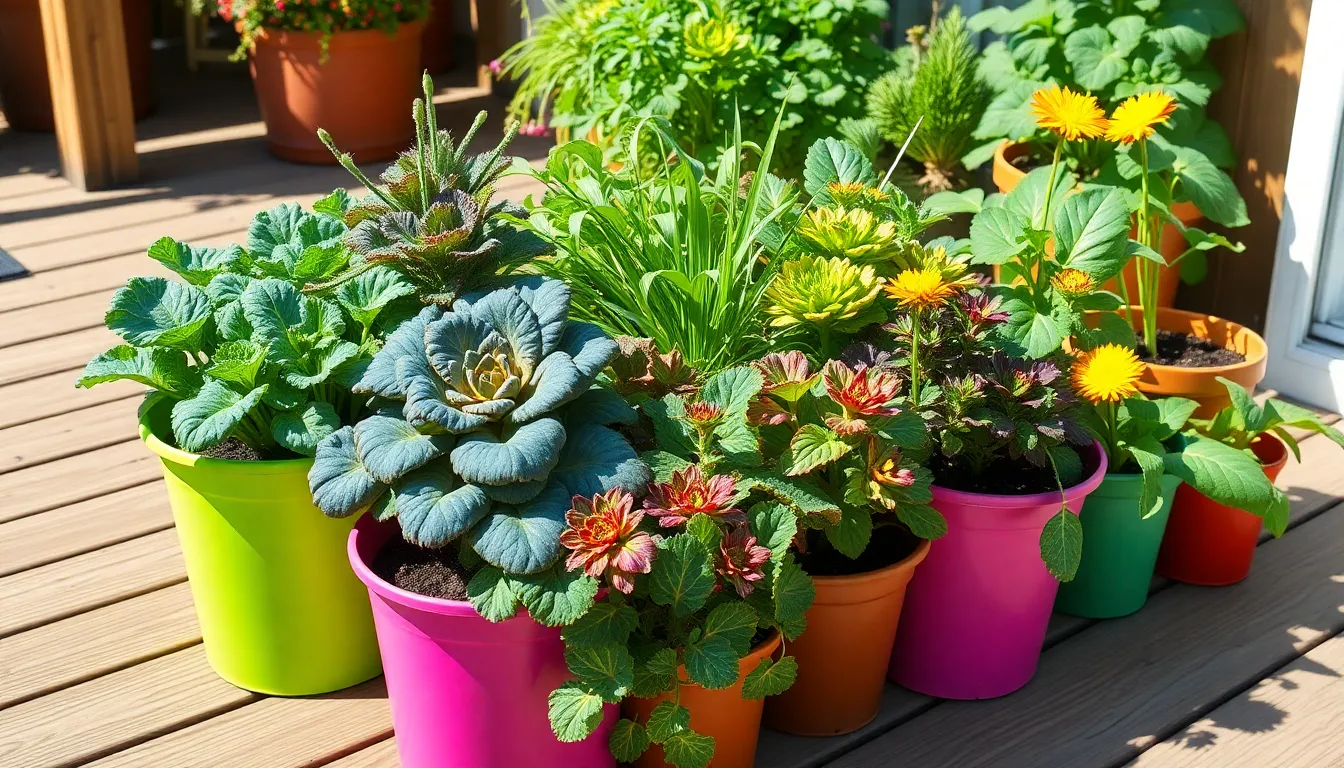
Adapting your container garden to the changing seasons ensures year-round productivity and protects your plants from extreme conditions. With thoughtful planning, you can maximize harvests throughout the year and keep your container garden thriving regardless of weather fluctuations.
Spring Container Planting Ideas
Spring offers the perfect opportunity to kickstart your container vegetable garden with cool-weather crops. Start by preparing containers with fresh potting mix as the soil in containers warms up more quickly than garden beds, making it possible to grow vegetables earlier in the spring. This temperature advantage gives container gardeners a head start on the growing season.
Plant cold-tolerant vegetables like peas, kale, and lettuce in early spring when temperatures are still cool. Peas particularly love chilly weather, so sow the seeds while it’s still cool and consider succession planting in large containers for extended harvests. Compact varieties like ‘Tom Thumb’ and ‘Little Marvel’ work exceptionally well in containers.
For spring root vegetables, try turnips and radishes, which mature quickly and don’t require deep containers. Newer turnip varieties are more compact and can be harvested fresh like radishes. ‘Silky Sweet’ turnips offer pretty, crunchy white flesh and their greens are edible too, giving you double the harvest from a single container.
Include leafy greens in your spring lineup as they thrive in the mild temperatures. Lettuces and salad greens are perfect spring crops that look attractive in decorative pots. Try pre-mixed varieties like mesclun for both visual appeal and diverse flavors in your spring salads.
Summer Heat Management Techniques
Container gardens face unique challenges during summer months as soil temperatures in pots can rise 15 degrees Fahrenheit higher than in-ground gardens. Carry out strategic shading during peak afternoon hours to protect sensitive crops from intense sun exposure without compromising their light requirements.
Choose light-colored containers over dark ones to reflect rather than absorb heat. Dark containers accumulate solar heat, which intensifies root temperature. This heat can benefit warm-season crops like eggplants, peppers, tomatoes, and okra that love warm roots, but can stress cool-season vegetables like onions and celery.
Increase watering frequency during hot weather as containers dry out much faster than in-ground gardens. During the hottest days of summer, many container plants need watering twice daily. Consider self-watering containers or drip irrigation systems to maintain consistent moisture levels and reduce the manual watering burden.
Apply mulch to the soil surface in your containers to reduce evaporation and moderate soil temperature fluctuations. A 1-2 inch layer of organic mulch like straw or shredded leaves helps retain moisture and keeps roots cooler during intense summer heat.
Group plants with similar water and sun requirements together to simplify care. For example, place heat-loving vegetables like tomatoes and basil in one area, while keeping moisture-loving plants like cucumbers together in another. This arrangement allows for more efficient watering and environmental management.
Fall and Winter Container Gardening
Extend your growing season into fall by planting cool-season crops in late summer. Kale is particularly well-suited for fall container gardening as it’s a hardy green that doesn’t mind cold temperatures. Plant kale in mid to late summer for harvests through fall and early winter.
Protect your fall containers from early frosts by moving them to sheltered locations or covering them with frost cloth when temperatures drop. The mobility of container gardens gives you a important advantage when cold weather threatens, allowing you to extend the harvest season by several weeks.
Consider cold frames or mini hoop houses to create protected environments for winter container gardening. These structures trap heat and shield plants from harsh winds, allowing cool-season crops to continue producing even as temperatures drop.
Plant winter-hardy herbs like rosemary, thyme, and sage in containers that can be moved indoors or to protected areas during extreme weather. These perennial herbs provide fresh flavors throughout winter when placed in sunny windows or under grow lights.
Use larger containers for winter gardening as they provide better insulation for root systems. The soil in small containers freezes more quickly and thoroughly than in larger ones, so choose pots at least 12 inches in diameter for winter crops to improve cold resistance and plant survival rates.
Troubleshooting Common Container Garden Challenges
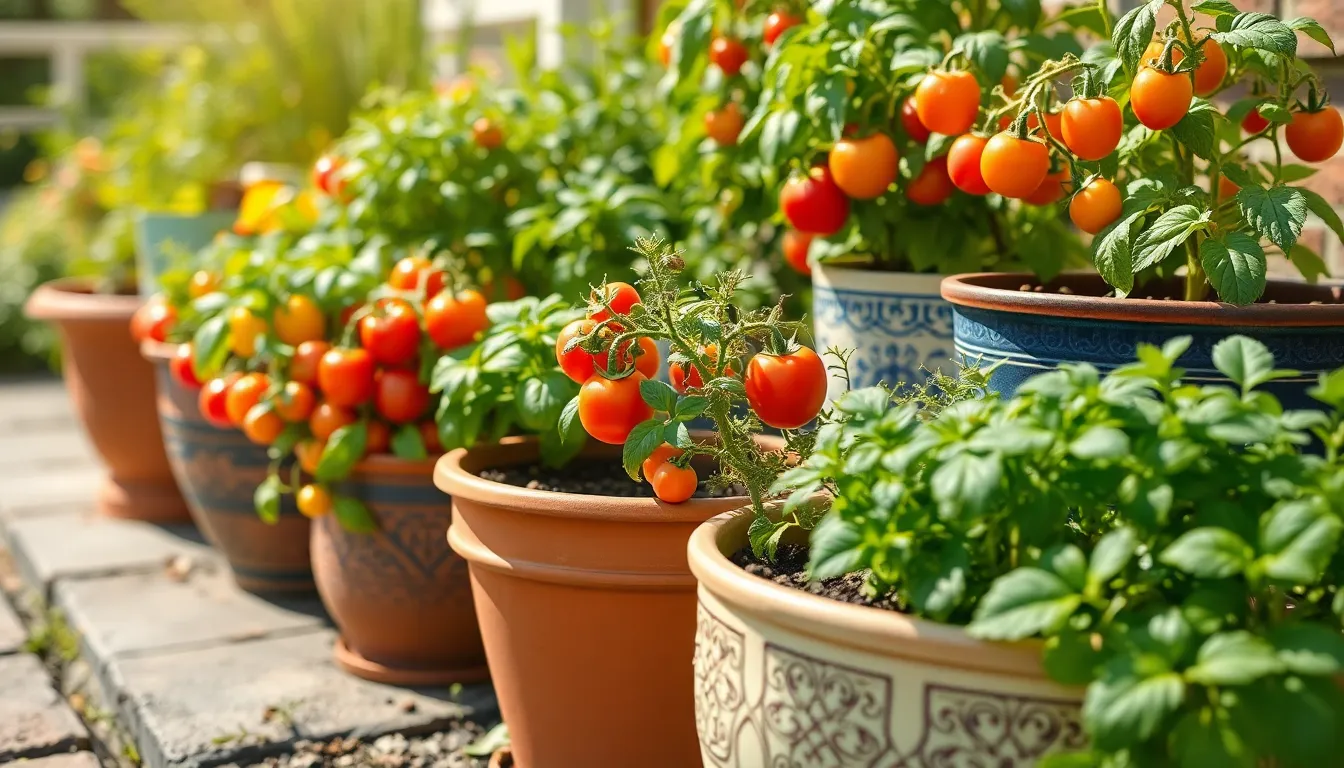
Even the most dedicated container gardeners face obstacles from time to time. Knowing how to identify and solve common problems will keep your vegetable garden thriving throughout the growing season.
Addressing Drainage Issues
Poor drainage is the leading cause of container garden failure. You’ll notice signs of drainage problems when water pools on the soil surface or plants develop yellowing leaves and stunted growth. Here’s how to fix common drainage issues:
- Add drainage holes: If your container lacks sufficient drainage, drill 4-6 holes (at least 1/4 inch wide) in the bottom. For decorative pots without holes, use them as cache pots with properly draining containers inside.
- Elevate containers: Place containers on pot feet, bricks, or wooden blocks to ensure water flows freely through drainage holes rather than becoming trapped.
- Improve soil structure: Replace compacted soil with fresh potting mix that contains perlite, vermiculite, or coarse sand to enhance drainage. Avoid using garden soil which compacts easily in containers.
- Layer properly: Add a thin layer of industry fabric or coffee filters over drainage holes to prevent soil from washing out while allowing water to escape.
Preventing Container Plant Diseases
Container plants can develop diseases even though being isolated from ground soil. Taking preventative measures is more effective than treating problems after they appear:
- Rotate crops: Even in containers, avoid planting the same family of vegetables in the same pot season after season. This prevents disease buildup in the soil.
- Maintain proper spacing: Overcrowded plants create humid conditions that promote fungal diseases. Follow spacing recommendations even in containers.
- Water correctly: Apply water directly to the soil rather than wetting foliage. Morning watering allows leaves to dry completely before evening, reducing fungal issues.
- Use clean containers: Thoroughly clean and disinfect pots between plantings with a 10% bleach solution to eliminate disease pathogens.
- Select disease-resistant varieties: Look for vegetable varieties specifically bred to resist common diseases—these are especially valuable in container gardens where conditions can be more intense.
Managing Pests in Container Gardens
While container gardens typically have fewer pest problems than in-ground gardens, they’re not immune to unwanted visitors. Here’s how to keep pests under control:
- Inspect regularly: Check the undersides of leaves and stems twice weekly for early signs of pests. Early detection means easier treatment.
- Introduce beneficial insects: Attract ladybugs, lacewings, and parasitic wasps by planting small-flowered herbs like dill and cilantro among your vegetables.
- Create physical barriers: Use row covers on hoops over containers during insect breeding seasons, removing them during flowering for pollinator access.
- Try companion planting: Grow pest-repelling plants like marigolds, nasturtiums, and herbs such as basil and mint alongside vegetables to deter common pests.
- Use organic controls: Apply insecticidal soap or neem oil for soft-bodied insects like aphids. For larger pests like caterpillars, hand-pick or use Bacillus thuringiensis (Bt), a natural bacteria that targets exact insect larvae.
- Refresh soil annually: Many pests overwinter in soil, so replacing container soil each spring eliminates this hiding place and gives plants a fresh start.
Conclusion
Container vegetable gardening offers endless possibilities for growing your own fresh produce no matter how limited your space may be. Whether you’re transforming a tiny balcony into a thriving garden or maximizing your patio’s potential you’ve got many creative options at your fingertips.
With the right containers proper soil and thoughtful planning you’ll soon enjoy homegrown vegetables that taste better than anything from the store. Start small experiment with different containers and plant varieties and watch your confidence grow alongside your vegetables.
Remember that gardening is a journey not a destination. Each season brings new learning opportunities and rewards. So grab those containers fill them with soil and get growing! Your personal produce section is just a few seeds away.






